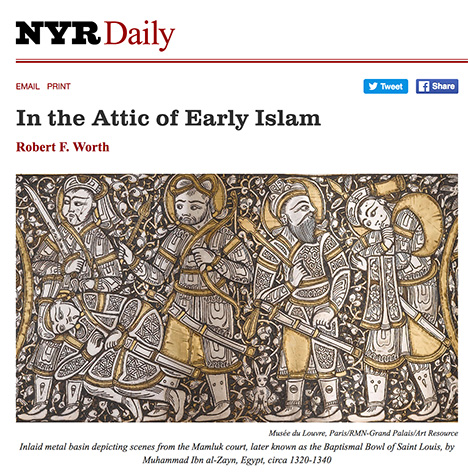There is a recent documentary on the Zabbalin garbage collectors of Cairo, produced by RT.
Persian Muscle Men

Following the Iranian Revolution of 1979, the sporting activities in the Zurkhaneh were declared inappropriate. Nowadays, however, they have become a symbol of Iranian national pride.
Persia’s “power houses” packed a punch
Qantara
Varzesh-e Zurkhaneh-i, (literally, the sport of heroes in the house of power). The ancient Iranian Zurkhaneh gymnasia have their roots in customs and traditions that date back to the country’s pre-Islamic past. This selection of early photographs portrays the world of the Zurkhaneh athletes from 1789 to 1925.
Al-Nuwayri on the Pleasures of Life
A post about the famous 14th century Mamluk text of al-Nuwayri, with a new English translation of excerpts from this classic compendium now available.
Weapons of the Syrian War
For an animated video of the weapons used by all sides in Syria, click here.
by Ben Watson, Defense One, July 19, 2016
From chlorine gas to Kalashnikovs, barrel bombs to cruise missiles, the Syrian conflict shows what 21st-century militaries and armed groups can bring to bear.
The Assad regime’s bloody reaction to the 2011 Arab Spring ignited one of the most lethal rebellions in modern history, placing it in the crosshairs of more than 1,000 armed groups: rebels, Kurds, defectors, extremists and countless others, including foreign military experts. Taken together, the opposition is better equipped than any the world has seen in generations, according to Charles Lister, Middle East analyst and resident fellow at the Middle East Institute.
“Syria represents the Afghanistan of the 21st century, but on steroids. The scale of jihadist militancy in Syria is one thing; the capability that they have acquired,†Lister said, “is at least in my opinion unprecedented in modern history.â€
The weapons on display in the Syrian war include some of the world’s most advanced and deadly, thanks to the U.S.-led campaign against the Islamic State and Russia’s own arrival in 2015.
Hundreds of thousands of people have died in the war; the UN stopped counting at 191,000 three years ago, but estimates range from a quarter million to at least 470,000. The conflict has uprooted half of Syria’s pre-war population, scattering five million people beyond its borders.
Onomasticon Arabicum
Onomasticon Arabicum (OA) is a long-living database project. This new online-version informs on more than 15000 scholars and celebrities from the first Muslim millenary. Its entries in Arabic are compiled from ancient biographical dictionaries, a veritable treasure of Islamic culture. Crossed search allows separate interrogation on any of the different elements of the Arabo-Muslim names, dates and places, reconstructing the identity of a person, trace ways of knowledge transmission and frame historical contexts.
Trump’s Muslim Bashing
The Atlantic (June 16) has a powerful piece by Uri Friedman on Donald Trump’s rampant Muslim bashing with responses by six Muslim commentators and scholars. It is well worth reading.
Arabic Writing before Islam
In most world history survey courses, Arabia is introduced for the first time only as backstory to the rise of Islam. We’re told that there was a tradition of oral poetry in Arabic, a language native to central Arabia, and that the Qur’an was the zenith of this oral tradition. New evidence, however, suggests that Arabia was linguistically diverse, that the language we’ve come to know as Arabic originated in modern day Jordan, and that the looping cursive writing system that’s become the language’s hallmark wasn’t the original system used to write it. What to make of all this?
Guest Ahmad al-Jallad co-directs archaeological/epigraphic projects in Jordan and Saudi Arabia, uncovering new inscriptions thousands of years old, and shares his research that’s shedding new light on the writings of a complex civilization that lived in the Arabian peninsula for centuries before Islam arose.
Click here to hear the broadcast.
Advanced Course in Arabic Manuscript Studies
The Islamic Manuscript Association, in cooperation with Cambridge University Library and the Thesaurus Islamicus Foundation, is pleased to announce an advanced short course in manuscript studies, entitled Scholars, Scribes, and Readers: An Advanced Course in Arabic Manuscript Studies, which will be held at Cambridge University Library from 6 to 10 June 2016.
This intensive five-day course is intended for researchers, librarians, curators, and anyone else working with Islamic manuscripts. As an advanced course, it is particularly aimed at those who already have some experience in Islamic codicology and palaeography and all participants must have a good reading knowledge of Arabic. The course will focus on Arabic-language manuscripts from various regions, including historical Turkey, Iran, and India. It is hoped that this advanced course will allow participants to gain greater exposure to and familiarity with the vast array of practices encountered in Arabic manuscripts.
The workshop will consist of three days of illustrated, interactive lectures on selected manuscripts and two days of hands-on sessions focusing on a selection of manuscripts from the Cambridge University Library collection. The manuscripts selected for presentation by the instructor cover the whole range of scribal practices encountered in a variety of subjects/genres, geographical regions, and historical periods (see the programme for details).
Continue reading Advanced Course in Arabic Manuscript Studies






